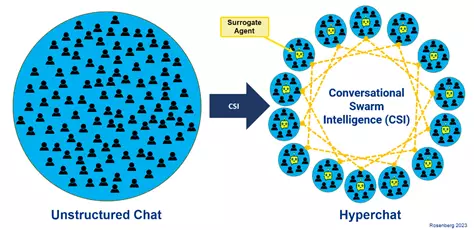Envision a scenario where a congregation of 200 diverse minds engages in an efficient and profound conversation, sharing ideas seamlessly and swiftly honing in on optimal solutions informed by AI. The concept may seem idealistic, yet it is becoming increasingly plausible with the emergence of generative AI technologies. One such novel approach is “conversational swarm intelligence,” colloquially known as hyperchat. This innovative technology aims to facilitate robust discussions among large groups, nurturing collective intelligence in real-time. The underlying question is whether this process can elevate the decision-making capabilities of groups, rendering them more adept than their individual members.
To explore this hypothesis thoroughly, researchers from Unanimous AI undertook an intriguing experiment. They gathered 50 sports fans to collaboratively construct a March Madness bracket via the hyperchat platform, Thinkscape. This endeavor is not merely a casual pastime; the intent is to evaluate whether a large group can outperform typical expectations associated with collective effort, particularly when tackling a complex challenge such as filling out a tournament bracket.
The Challenges of Large-Scale Conversations
But can a group of 50 people be effectively coordinated without descending into chaos? Studies show that optimal conversation thrives in smaller settings—typically between four to seven participants—where individuals can communicate fluidly with high engagement and minimal wait times. Beyond this range, discussions tend to fragment, resulting in an utter lack of cohesion. Once groups grow beyond 20 participants, the likelihood of productive dialogue diminishes as participants face overwhelming competition for airtime, fracturing into disconnected monologues rather than collaborative exchanges.
Hyperchat’s innovation lies in its ability to dissect myriad participants into smaller, parallel subgroups. Each subgroup is then equipped with a “conversational surrogate,” an AI component designed to gather and clarify discussions within its group. This structure allows the AI surrogates to integrate insights across various subgroups, synthesizing a coherent dialogue out of many smaller conversations. This capability permits large teams to engage in meaningful collaboration, thus advancing the realm of collective intelligence without the typical bottlenecks of large meetings.
Real-World Applications and Early Findings
What implications does this have for organizations and teams? In practical applications, hyperchat has already showcased its capabilities in enterprise settings. The Thinkscape platform has enabled extensive deliberations among hundreds, marking a significant acceleration in how groups communicate and resolve challenges. In the case of the March Madness experiment, participants showcased an impressive collective performance, placing their bracket in the 99th percentile among millions of other entries. Such outcomes provide compelling evidence of hyperchat’s potential to harness group intelligence effectively.
Moreover, research has demonstrated that participants in hyperchat scenarios demonstrate a marked improvement in their problem-solving abilities. A study conducted by Carnegie Mellon University and Unanimous AI revealed that groups using hyperchat significantly raised their collective IQ scores compared to individual performance when tackling standardized tests. The findings indicated a dramatic increase in effective intelligence—showing that the structure of hyperchat enables groups to transcend their baseline capabilities by leveraging collaborative dialogue.
The Power Shift: Human-AI Collaboration
What sets hyperchat apart is not just its promise for human interaction, but the integration of AI into the collaborative framework. The structure is designed to allow hybrid teams consisting of human participants alongside AI agents that contribute relevant information in real-time. Known as “contributor agents,” these entities enable humans to focus on deliberation while providing factual inputs to enhance decision-making processes. Such a layered approach serves to amplify the group’s intelligence further, cultivating a hybrid superintelligence model that blends human creativity with AI precision.
In another fascinating experiment, groups were tasked with fielding fantasy baseball teams using hyperchat. Feedback indicated that 87% of participants found the experience significantly enhanced their decision-making capabilities. This speaks volumes about the transformative potential hyperchat holds for collaborative efforts across various domains, particularly where large-scale deliberation is essential.
Revolutionizing Collaboration in the Corporate Arena
The implications extend into the corporate sphere, where major organizations often grapple with bottlenecks in communication and decision-making. For Fortune 1000 companies with thousands of employees, hyperchat could revolutionize how teams function, opening avenues for real-time deliberation and enhanced collective outcomes. By harnessing the power of AI and streamlining communication at scale, businesses can transcend traditional constraints, achieving more agile and informed decisions while retaining human oversight.
Ultimately, hyperchat signifies a profound shift in how we visualize collaboration among teams, challenging the long-held notion that productivity is exclusive to smaller groups. As the sports world eagerly anticipates the culmination of the March Madness tournament, the real treasure lies not just in the outcomes but in the compelling evidence that artificial intelligence can unlock new heights of collective intelligence—transforming how we collaborate in the face of complex challenges.

